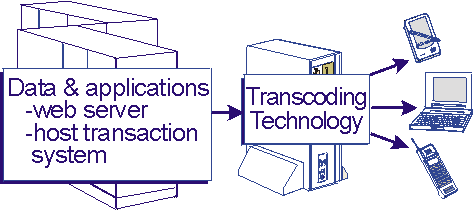Solutions
Overview
Transcoding Technology gives you the ability to tailor Web-based information to the needs of users. For example, you can make Web pages available on handheld and other devices economically and efficiently. You can format XML-based information for HTML browsers and other uses. You can convert data to voice output. Working with WebSphere Translation Server, Transcoding Technology can translate information into the user's preferred language.
With Transcoding Technology, your users receive information tailored to the capabilities of the devices they are using. For example, users with small-screen devices access a scaled version of the information, while users of a specialized markup language access the same information in a format suitable for their devices. By providing a single dissemination point for multiple renderings of information, Transcoding Technology eliminates the expense of re-authoring or porting data or applications for multiple networks and devices. Transcoding Technology improves the communications and effectiveness of your mobile employees and extends the reach of your information to a new class of users.
Transcoding Technology transforms content based on what the requesting device can handle. Web content can be transformed differently for different devices. Transcoding Technology supports your existing applications and data without requiring that you redesign corporate systems for the different standards found in each device. Transcoding Technology can support all common types of Web data, including HTML pages, and Extensible Markup Language (XML). Transcoding Technology also tailors images to adjust screen size, file size, and numbers of colors.

Transcoding Technology provides standard transformations for several leading pervasive devices. You can modify transformations based on criteria important to you or your users. For example, if your users on the road want to sacrifice aesthetics for download speed, you can tell Transcoding Technology to reduce image file size (or remove images, or convert them to links) and transform table formats to simpler list formats. As new devices emerge in this fast-growing market, new transformations can be added easily. For specific or unique format requirements, Transcoding Technology provides a pluggable framework for adding new device and content type transformations.
Transcoding Technology transforms data before transferring it, which saves connect time and cost. Data manipulation is done on the network side of a connection, rather than in the device browser. This gives you more control over the data transformation as well as the amount of data transferred and reduces processing on the device itself.
How does Transcoding Technology transform content?
Transcoding Technology helps you ensure that Web data delivered to a device is appropriate for the device and your administrative policy in terms of:
- Size - scaled presentation of images and compression of text, which could, for example, reduce the size of files that are downloaded
- Detail - specifically tailored to the amount and kind of information your users need
- Format - data presented in the format supported by your users' device types
- Language - data translated into your users' languages
Solutions
These solutions illustrate some of the ways Transcoding Technology can be used in your organization.
- Web application output tailored for road warriors
- Your sales force uses monochrome handheld devices
to access a Web-based product catalog.
The Web pages contain full-color graphics, text descriptions,
and order forms.
You configure a Transcoding Technology server to perform the following
operations before transmitting Web pages to these users:
- Format tables to lists
- Change paragraph tags to line breaks to save space by eliminating blank lines between paragraphs
- Convert images to text links, speeding the page download, but still providing access to images
- Convert images to grayscale and reduce their resolution to speed download time
- The result is that the forms are intact but sized for the screen. The sales force can place orders faster and with fewer problems in displaying the relevant data.
- Host data transformed in secure environment
- A host transaction system generates financial data for a secure Web server. Your market finance group needs access to this data from their office desktops as well as from their mobile devices. Transcoding Technology transcodes the output of Web applications to the proper formats, and the Web server encrypts and returns the data.
- Multi-version support for devices
- Transcoding Technology transforms content for a device that does not support JavaScript by removing the JavaScript from any document that contains it. A vendor upgrades the device to support JavaScript. You obtain a new device preference profile from the vendor. You configure WebSphere Everyplace Access to recognize the new device and indicate in Transcoding Technology's matching preferences the upgraded capability. Any user who accesses WebSphere Everyplace Access with the new device receives content containing JavaScript. Users with back-level devices continue to get content without JavaScript.
- Deck fragmentation for smaller devices
- Your employees use handheld devices with screens that display small amounts of data received using the WML or Compact HTML formats. Transcoding Technology converts the original HTML to the appropriate markup language and then breaks the information into fragments of the size the phone can store. This means that application developers do not have to write different versions to support phones with different capacities.
See also